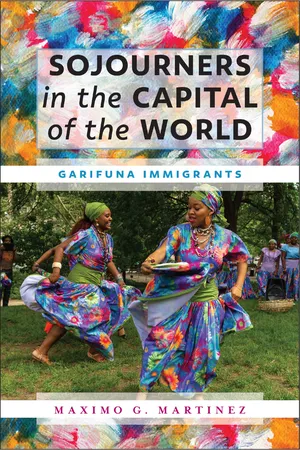
- English
- ePUB (mobile friendly)
- Available on iOS & Android
About this book
A comprehensive history and insider's account of the Garifuna in New York City from 1943 to the present day. In recent years, Latinos—primarily Central American migrants—crossing the southern border of the United States have dominated the national media, as the legitimacy of their detention and of U.S. immigration policy in general is debated by partisan politicians and pundits. Among these migrants seeking economic opportunities and fleeing violence from gangs and drug traffickers are many Central American Garifuna. This fascinating book is the long-overdue account—written by a Garifuna New Yorker—of the ways that Garifuna immigrants from Guatemala, Belize, and Honduras have organized themselves and become a vibrant presence in New York City, from the time of their first arrivals in the 1940s to the present.The author documents four generations of Garifuna people in New York City who were active in the organizations at the heart of their community. Garifuna organizations have expanded and diversified over time from being primarily concerned with simply providing a space to gather for social events and some self-help groups for seamen (who were the first migrants) to a wide variety of organizations today that range from those focused on culture—music, dance, religion, language, sports, media—to those concentrating on economic development, political engagement and representation, immigration issues, health concerns, and transnational projects related to the situation of Garifuna in their Central American communities. As the Garifuna population grew, their organized entities simultaneously increased. The legacy of the Garifuna ethnic group is one of heroic resilience: They challenged colonial European suppression and grew from an estimated population of 2, 000 to a growing 600, 000 in the present day. After wars defending their original settlement on the Caribbean island of St. Vincent, the remaining Garifuna were rounded up and expelled from the territory to Central America, and from there they eventually immigrated to the United States. In New York City, an estimated 200, 000 Garifuna live in the five boroughs, with their largest population in the Bronx. Having overcome numerous challenges, this Black/ Indigenous ethnic group is now known for its significant involvement in both Central American as well as U.S. societies.The Garifuna are integrated into the fabric of New York City as a distinctive Afro-Latinx/African Diaspora ethnic group known for its cultural and political impact. Garifuna organizations are at once concerned with creating alliances with a diversity of many other groups and also focused on dealing with issues specific to the unique culture, history, and situation of the Garifuna. They provide an interesting case study on whether and how Black ethnic groups assimilate with African Americans. And awareness of this group, its culture, and its contribution to American society is essential to understanding a growing segment of the expanding diverse Latino presence in the United States.
Frequently asked questions
- Essential is ideal for learners and professionals who enjoy exploring a wide range of subjects. Access the Essential Library with 800,000+ trusted titles and best-sellers across business, personal growth, and the humanities. Includes unlimited reading time and Standard Read Aloud voice.
- Complete: Perfect for advanced learners and researchers needing full, unrestricted access. Unlock 1.4M+ books across hundreds of subjects, including academic and specialized titles. The Complete Plan also includes advanced features like Premium Read Aloud and Research Assistant.
Please note we cannot support devices running on iOS 13 and Android 7 or earlier. Learn more about using the app.
Information
Table of contents
- Cover
- Title Page
- Copyright
- Contents
- Preface
- Introduction
- 1. Origins, Surviving, Ensuring Subsistence, and Culture
- 2. Livelihood on the Caribbean Coast
- 3. Early U.S. Garifuna Communities
- 4. Identity and Cultural Growth: Garifunadao
- 5. Music, Dance, and Sports from the 1990s to the Present
- 6. Social Issues in New York City from the 1990s to the Present
- 7. Central America and St. Vincent from the 1990s to the Present
- Conclusion
- Appendix A: U.S. Garifuna Merchant Marine Seamen Crew Ship List, 1920s–50s
- Appendix B: Honduran Garifuna Organizations Participating at the Garifuna Nation Pocono Retreat, 2005
- Appendix C: U.S. Immigration Data from Belize, Guatemala, Honduras, 1930–2017
- Appendix D: Bronx Community Board Appointees, 2019–20
- Appendix E: Founding Members of the Garifuna Coalition USA
- Acknowledgments
- Notes
- References
- Index
- About the Author